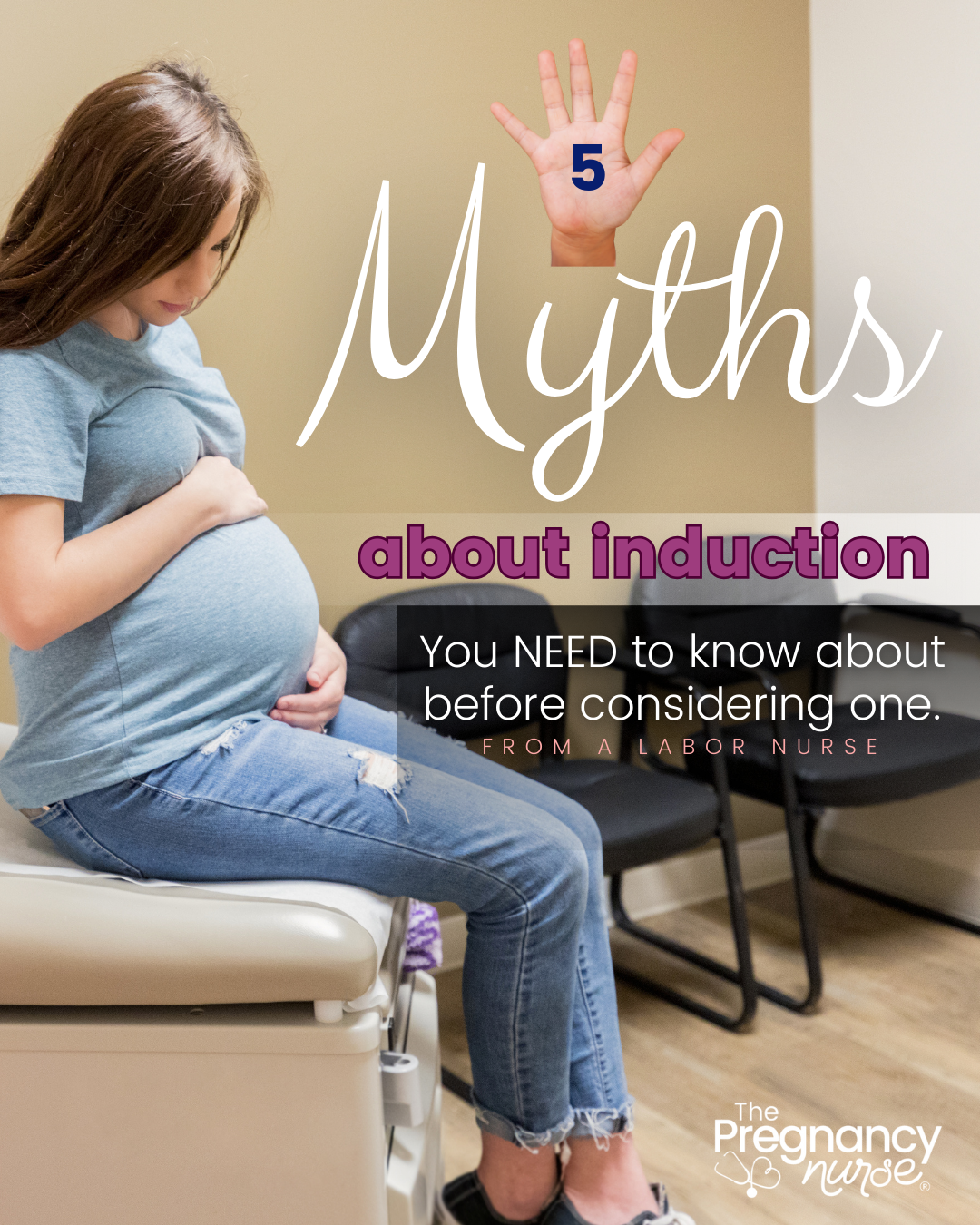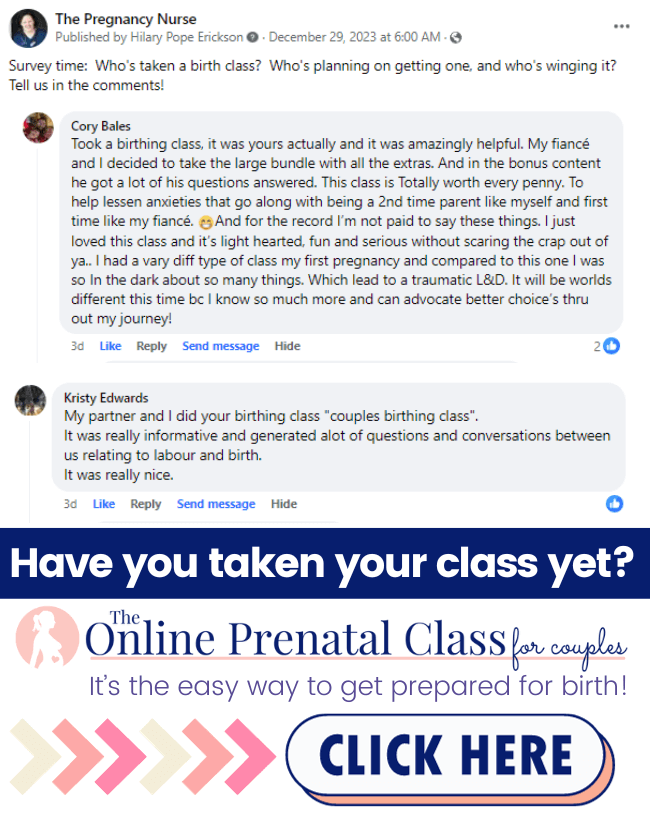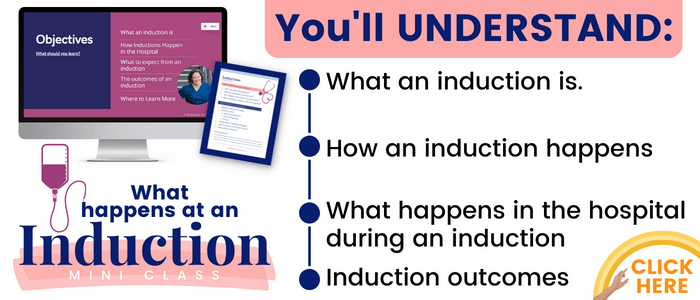📣 YOU are clearly getting prepared for pregnancy, birth & beyond — but do you wish your partner was more involved (looking for a teammate rather than just a cheerleader)? Couples love THIS! 💛🧡💚
Today I want to share five myths about induction. Things everyone thinks is true, but isn’t always (or ever).
For a few pro-tips about me — I have not only been a nurse for basically forever, but also have had 3 of my own. My last one was an induction after being 12 days overdue. SO, not only have I seen thousands of inductions, I’ve also had my own. I’ll be using both of those data sets as I write this article.
Really quick though, if you’re thinking about an induction it is more important than ever to get prepared for your birth. I’m not just talking the hee-hee-hoo breathing parts. I’m also talk about learning how to get the information you need to make the RIGHT choices. Beyond the basic choice of an induction you may also have other choices as the induction continues — and being prepared for all of that is imperative.
I recommend this class — I hope you’ll check it out.

OK, onto the induction myths!
Myths about Induction
They Hurt More
Everyone says inductions hurt more.
The thing is, all labor hurts about the same. BUT, labor hurts less when you’re at home. Where you can watch your favorite shows in your couch or bed. You can take long showers, eat brownies. Get stuff done.
You’re distracted.
The hospital is nice enough to take away all those distractions leaving you just with the pain and deciding if you need to get up and pee.
SO, it may feel like it hurts more, or that it takes longer. Often you’re starting behind the ball without all those “practice” contractions you might have had if you had gone overdue.
Of cousre, the hospital also have plenty of pain management options as well.
I’m a HUGE fan of staying home as long as possible during labor (which I teach in here). With an induction that’s just not possible. BUT there are things you can do, even while being monitored, to make it all better.
You can’t eat during them
A lot of healthcare providers say you can’t eat when you’re on pitocin (which is why I recommend eating before an induction).
I believe the reasoning is that it is a higher risk medication (more likely to have cesarean section). Also, that you might vomit if you eat.
However, that’s just a doctor’s order.
And turns out, the only one who has to follow those is me (the nurse/hospital staff). I can’t order or bring you food. What you do is up to you.
Yes, you might throw up, but that’s up to you.
Note: A LOT of women think it will be MISERABLE to go without food during labor. However, your body is so concentrating on getting the baby out it just doesn’t get hungry.
However, if you are hungry in labor and the nurse says she can’t feed you, maybe ask why.
If there truly is a high risk of a cesarean section soon I probably wouldn’t eat, but I would recommend having a frank conversation with your providers. This is one of those things it’s handy to have some preparation on how to talk with providers to get the information you need to make YOUR choices (remember it’s never their choice — even if they make it seem that way).
Also, when you’re on other medications like Cytotec, you often CAN eat (depending on how they give it to you).
BTW, I usually recommend some snacks just in case in your hospital bag. Grab my packing list here:
You just have to do what your doctor tells you to.
Going along with the last section, if your doctor says you need to be induced that should be accompanied by informed consent.
That means:
- The risks (all inductions do come with potential risks different than spontaneous labor)
- The benefits
- The alternatives
You wouldn’t have a flooring contractor come in your home and tell you that you need wood floors and then just have them put them in.
You’d ask them why they think that would be best, what will be good or bad about them, and if they had any other suggestions.
Your body and your delivery should be the same way.
Doctors don’t make decisions for you, you do. They recommend things.
As you’re probably able to tell at this point, this is a soapbox issue — but I think it’s really important you understand this.
In fact, as I look at it — a caesarean section is both a risk and an alternative to an induction, so it’s complicated.
And yes, there is an art to getting the information you need and letting providers know they’ve been heard. I talk about that in the provider communication bonus in here.

Pitocin is the best for induction
For many providers pitocin has been their standard of care, but there are a few ways to start an induction. So, after you decide an induction is best. See how your doctor recommends to do it, and if you’re OK with that as well.
I talk ALL about the different ways to be induced in my post on 37 week inductions. They include medications or even just rupturing your amniotic sac.
These different types of induction methods (like prostaglandin gel) are chosen based on your cervix, your medical needs etc.
You can pick when you’re induced
Now, I’ve talked a lot about you having a choice in all of these things.
The one thing you don’t really get a choice over is if it happens.
It is strongly recommended doctors don’t do an elective labor induction (that means not medically-necessary) until at least 39 weeks of labor (in fact, my hospital won’t schedule inductions before 39 weeks of pregnancy if they don’t have a reason).
The ARRIVE trial really changed the landscape of the 39 week induction — but it doesn’t mean it’s right for you. I have a bonus video in here about it.
Many places won’t schedule an elective induction until after your due date.
Of course, you can definitely get induced if you have a medical reason like high blood pressure, low amniotic fluid, gestational diabetes, and other medical conditions or a clear medical reason that require baby to come out earlier. Check out my posts on reasons for an early induction.
Even if they schedule you, if inductions are medically necessary (meaning you have medical reasons to be induced) they may “bump” you. It’s not like a reservation at a restaurant. As a hospital we often have to take cases based on a medical need vs a reserved spot.
Induction FAQ’s
You need a healthcare provider with privileges’ at your chosen hospital. Most often it’s a midwife or a doctor.
No, some studies show it has an increased risk for induction (some show it does not) but it can end in a cesarean delivery.
Yes, although if you’re already contracting when we start induction agents, it’s called augmentation of labor. Once your bag of waters is open, some induction methods are not indicated at that time.
Yes. both parts of a pregnant woman are taken into consideration for an induction
No, I don’t believe so. I’d recommend that if you’re wanting to be induced, just be induced rather than something like castor oil that has many risks (and you are not being monitored). Things like spicy food don’t really work and so if you REALLY want to be induced, choose a way that is proven to work (safely)
Not exactly, it may take longer, but we don’t take that into consideration too much.
Most often your risk of infection is having your bag of water ruptured for too long, but many vaginal exams can increase your chance of infection as well. The longer you are in labor this risk would increase.
While you can definitely talk with your provider about your specific circumstances, most often you will need a vaginal exam prior to the induction process. The vaginal exam helps us rate you on a bishop score to know if your cervix is ready (or how ready it is for medically-indicated inductions).
I have looked to see if there are any studies, but I don’t see any percentages. I do think an elective induction is the most common reason (although there are more medically indicated reasons overall than elective inductions).
Membranes sweeps can start later, but most often do not. However, it is done to start labor — so they are hoping that it does that.
They can use the balloon for a catheter to push open your cervix. Often used with medications to induce people. Learn more about Foley catheters in this article.
So, that’s my five myths of inductions. If you want the WHOLE story about induction, don’t miss my Online Prenatal Class. You can get prepared for your entire delivery in 2-3 hours (or stretch it out much longer if you’d like to take your time). It’s all up to you! AND as a bonus to start today — use code MYTHS to get 10% off right now!

Not wanting a full class, but still want more info on inductions, check out Inductions Made Easy.








 Taking Care of Your Bottom & Perineal Care After Delivery
Taking Care of Your Bottom & Perineal Care After Delivery
